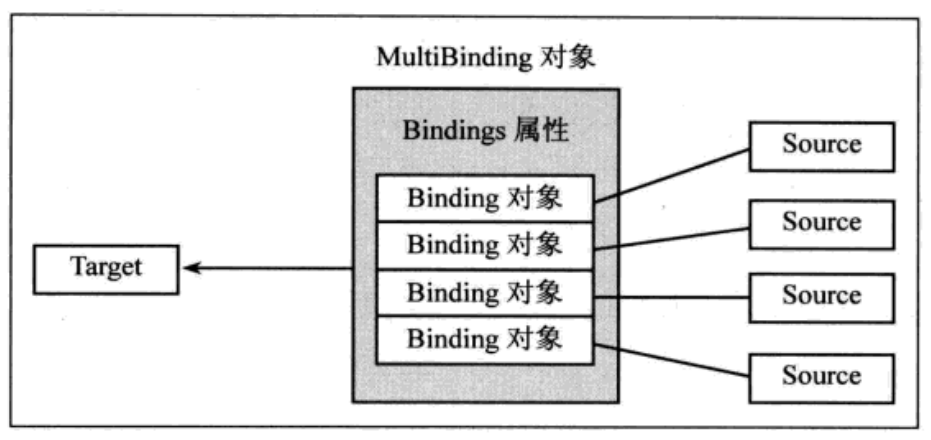开始
Binding 对象是实现数据和界面双向绑定的基础
在数据部分,数据源需要实现 INotifyPropertyChanged 接口,其中包含一个 PropertyChangedEventHandler 类型的 PropertyChanged 属性,该属性是一个事件,当数据源内的属性变化时,需要调用 PropertyChanged 来触发属性变化事件,从而能够通知到 UI 改变数据
数据源的基本实现如下
1 | public class Student : INotifyPropertyChanged { |
编写一个简单布局,在后台类中通过 C#代码的方式将 Student 类的 Name 属性绑定到文本框中(也可使用标签扩展),xaml 布局如下
1 | <StackPanel |
后台类如下
1 | public partial class MainWindow : Window { |
上述 Binding 对象的
Source属性可以接收任何对象,若对象没有实现INotifyPropertyChanged接口,则无法向 Binding 通知自身的状态变化,INotifyPropertyChanged提供了对象向 Binding 通知自身变化的能力
Binding 属性
Binding 对象的常用属性如下
| 属性名 | 描述 |
|---|---|
| AsyncState | 获取或设置传递给异步数据调度程序的不透明数据。 |
| BindingGroupName | 获取或设置此绑定所属的 BindingGroup 的名称 |
| Converter | 获取或设置要使用的转换器 |
| ConverterParameter | 获取或设置要传递给 Converter 的参数 |
| Delay | 获取或设置更新位于目标更改上的值之后的绑定源前要等待的时间(毫秒) |
| ElementName | 获取或设置要用作绑定源对象的控件元素的名称 |
| FallbackValue | 获取或设置当绑定无法返回值时要使用的值 |
| IsAsync | 获取或设置一个值,该值表示 Binding 是否应异步获取和设置值 |
| Mode | 获取或设置一个值,该值指示绑定的数据流方向 |
| Path | 获取或设置绑定源属性的路径 |
| RelativeSource | 通过指定绑定源相对于绑定目标位置的位置,获取或设置此绑定源 |
| Source | 获取或设置要用作绑定源的对象 |
| StringFormat | 获取或设置一个字符串,该字符串指定如果绑定值显示为字符串时如何设置该绑定的格式 |
| TargetNullValue | 获取或设置当源的值为 null 时在目标中使用的值 |
数据流向
通过设置 Binding 对象的 Mode 属性可以改变 Binding 数据的流向,Mode 属性是 BindingMode 类型,拥有四个枚举值
- OneWay:单向流动
- TwoWay:双向流动,默认值
- OnTime
- OneWayToSource
- Default:根据控件的读写属性确定单向或双向
Path 路径
Path 属性指定绑定的数据源属性
-
直接路径:直接指定属性名
1
2
3<!--通过标签扩展引用其他元素的属性-->
<TextBlock Text="Hello World" x:Name="MyText"></TextBlock>
<TextBlock Text="{Binding ElementName=MyText, Path=Text}"></TextBlock> -
多级路径:可以获取属性的属性
1
2
3
4
5
6<!--通过标签扩展引用其他元素的属性-->
<TextBlock Text="Hello World" x:Name="MyText"></TextBlock>
<!--Path指向Text的Length属性-->
<TextBlock Text="{Binding ElementName=MyText, Path=Text.Length}"></TextBlock>
<!--使用Text的索引器,点.可以省略-->
<TextBlock Text="{Binding ElementName=MyText, Path=Text.[0]}"></TextBlock> -
默认路径:当绑定的数据源自身就是数据值时,使用默认路径
当数据源是一个集合时,使用
/表示第一个元素的默认路径1
2
3
4
5
6<Window.Resources>
<sys:String x:Key="MyValue">Hello</sys:String>
</Window.Resources>
<TextBlock Text="{Binding ., Source={StaticResource MyValue}}"/>
<!--等价于-->
<TextBlock Text="{Binding Path=., Source={StaticResource ResourceKey=MyValue}}"/>
数据源
Binding 指定数据源主要通过 Source 属性,下面介绍通过不同的途径设置 Binding 数据源
CLR 属性和依赖属性
CLR 属性就是普通对象的普通属性,与依赖对象的依赖属性区分
依赖对象继承了 DependencyObject 类,依赖属性为 DependencyProterty 类型,命名后缀通常是 Property,在 xaml 中引用时会省略该后缀。依赖属性是依赖其他属性的属性,如控件的可绑定属性,通常作为 Binding 的目标
同时依赖对象也可作为 Binding 的源,当作为 Binding 源时,该依赖对象可能是其他 Binding 的目标,从而形成依赖链
DataContext
Binding 将 DataContext 的值作为数据源,Path 属性指定数据源中的属性
1 | <!--可以省略点.--> |
DataContext 是 FrameworkElement 的属性,是 object 类型,每个控件都拥有自己的 DataContext,DataContext 是一个依赖属性,当控件的 DataContext 没有显式赋值时,会依赖父控件的 DataContext,因此当 Binding 指定路径时,可以自动获取到父控件或祖先控件的 DataContext 中的属性
1 | <StackPanel> |
集合类型
ItemsControl 控件拥有 ItemsSource 属性,接收一个实现 IEnumerable 接口的对象作为数据源
DataTemplate 类定义了单个子项数据通过哪些控件展示,DataTemplateSelector 类的子类重写了 SelectTemplate 方法,实现了子项数据与控件的绑定(创建 Binding 对象),再使用 DataTemplate 将添加 Binding 的控件对象包装起来返回
1 | public virtual DataTemplate SelectTemplate(object item, DependencyObject container) { |
默认的 DataTemplateSelector 是 DisplayMemberTemplateSelector,它的 DisplayMemberPath 属性指定了数据源成员的路径,简单地将数据源成员通过 TextBlock 控件展示为一个字符串,其核心代码如下
1 | // 初始化DataTemplate和控件对象 |
在 xaml 中可以给 ItemsControl 自定义 DataTemplate,赋值给 ItemTemplate 属性
1 | <ListBox |
ElementName
ElementName 设置为其他控件的 x:Name,将被引用的控件对象作为 Binding 源
1 | <TextBlock Text="Hello" x:Name="Hello"/> |
RelativeResource
相对于当前元素,查找其他元素的属性
构造 RelativeSource 对象赋值给 Binding 的 RelativeSource 属性,将 RelativeSource 查找的元素作为源
- Mode:查找模式,FindAncestor 查找祖先,Self 查找自身
- AncestorLevel:确定祖先相对层级
- AncestorType:确定祖先控件类型,通过
x:Type获取Type类型
1 | <StackPanel |
其他数据源
-
ADO.NET类型对象DataTable、DataView 等
-
XML 数据
通过
XmlDataProvider将 xml 中的数据传递给集合控件数据源属性 -
ObjectDataProvider当数据通过方法获取时,使用
ObjectDataProvider包装数据源,再赋给 Source
数据校验
基本使用
Binding 对象包含一个 ValidationRules 属性,类型为 Collection<ValidationRule>,表示可以对一个 Binding 设置多个校验条件
ValidationRule 是一个抽象类,包含一个 Validate 抽象方法,返回 ValidationResult 对象
1 | public class RangeValidation : ValidationRule { |
Binding 校验默认只校验通过外部方法改变 Target 导致 Source 改变,不会校验 Source 改变导致 Target 改变,设置
ValidatesOnTargetUpdated属性为 true,校验 Source 导致的改变
校验错误事件
若需要 Binding 在校验错误时发出一个事件,需要设置 NotifyOnValidationError 属性为 true
校验错误事件会沿着元素树传播,当遇到一个元素设置了校验错误事件处理器,则该元素处理该事件,处理后可继续传播,也可立即停止
1 | // 定义事件处理器 |
数据转换
数据转换通过 IValueConverter 实现类实现
1 | public class MyConverter : IValueConverter { |
MultiBinding
MultiBinding 组合多个 Binding 的 Source,绑定到一个 Target
MultiBinding 支持 Binding 的基本属性,如 StringFormat、Mode、Converter 等

组合字符串的基本使用,xaml 标签扩展
1 | <TextBlock x:Name="MyText"> |
多值转换:实现 IMultiValueConverter 转换多个 Source
1 | public class MultiConverter : IMultiValueConverter { |